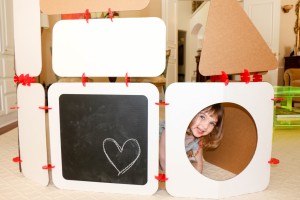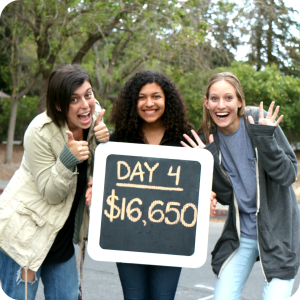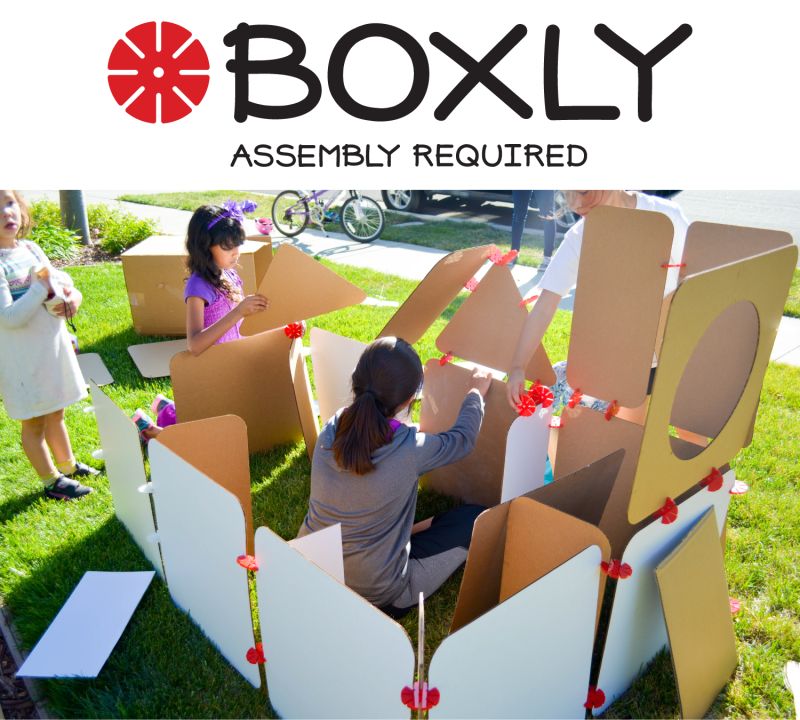These days, when we think about purchasing new toys, we usually look to Apple or TechCrunch. But three product design engineers are changing the way both kids and adults play by taking their customers back to the basics. Through their capstone product design class, the goal of which is to design a product and bring it to the market, Sasha Spivak (’15), Carolyn McEachern (’15) and Alicia Seta (’15) have created Boxly, a 100-percent recyclable fort-building kit. Originally the tag line had “for kids” tacked on the end, but when adults were demanding to play with it, too, they dropped the age qualification.
Spivak, McEachern and Seta decided to explore the toy space when they realized they shared a passion for kids, games and puzzles. They were frustrated by the status quo in the industry. “So many kids toys now come with a set of instructions and there’s one right way to use them or they are on an iPad and it’s the same every time you play,” says McEachern. “As product designers we are building with our hands everyday and that’s how we solve problems. So we wanted to come up with something that allows kids to do that at a young age.”
The next step was figuring out what to make. After talking to kids and their families, it became clear that fort building is a popular past time. But the problem with this hobby, to which many parents could attest, is that it takes over the whole living room and kids become attached to the obstructive structure because of the effort they have put into it. “So we wanted to make something that’s quick to put up and take down and let’s them get over this fear of failure and makes them curious instead,” explains Spivak.
They began to think about what families have lying around their houses and after considering toilet paper and wrapping rolls they settled on cardboard, thereby connecting the love of forts with the love of the cardboard box. And, thus, Boxly was born, a kit with cardboard pieces that users can put together with connecters; Boxly also allows people to incorporate any standard one-ply cardboard they might have lying around.
“The sustainability aspect was really important for us,” says Seta. “We wanted to make something sustainable that emphasizes reused materials. Kids toys are destined to be thrown away after they grow up, so why put it in the trash can when you could put it in the recycle bin?” One of the team’s design principles was that they wanted to create and package a product that creates no waste. “There is nothing in the Boxly kit that does not have a purpose,” explains Seta. “Even the box it comes in could be part of the form.”
As for the feedback so far, it has been overwhelmingly positive and supportive. “One of the most pleasant surprises is that kids want to do this on their own so parents can go do other things,” says Spivak.
“It was amazing to see kids playing with the product,” says Seta. “You show kids how to connect two panels together and then let them go crazy. It’s clear they’re having fun but it’s also really gratifying to see them get better at building the longer they play with it.”

In addition to enhancing the general toy-scape, Boxly has partnered with Camp Kesem to offer backers the option of donating a kit to Camp Kesem on Kickstarter. “We started out just wanting to make something fun,” says Seta. “But when we contacted Camp Kesem it turned into a project that could be impactful for a lot of kids.”
Two weeks ago, the Boxly team launched a Kickstarter campaign to raise $30,000 to send Boxly to market. They have currently raised two-thirds of their campaign goal, and have two weeks left. In the beginning, there was a huge influx of support and they were halfway funded in just four days. They have since reached out to family, the Stanford community, education professionals, design firms, after-school programs and even mommy clubs and mommy bloggers, which, apparently, is “a world of its own.”
The Boxly team has already reaped some rewards from the project. “One of the best parts has been the team. We have the same vision but different strengths so we complement each other really well,” says Spivak. For McEachern, the best part so far has been watching the kids play with it. “We have a chalkboard panel they can draw on and they will start with that because they’re comfortable drawing and then they’ll slowly start to build and then they’ll just fly with it and keep building bigger things. Watching them get comfortable with that process has been so rewarding.”

They have also gained business skills that evade many students until after their college careers. “This experience taught us how to start a company, how to work with manufacturers locally and overseas and how to take an idea through development all the way to production,” says Seta.
But no project is complete without a few glitches. When the team first looked at shipping costs, they were appalled by the prohibitively high costs. Essentially, they would have to charge each person $40 for shipping. But like true design thinkers they brainstormed and found a company, which was already shipping products expansively and agreed to take them on as a sort of child account. As seniors, it has also been challenging for them to pursue this project through graduation when everything else is wrapping up. But they are insistent on seeing Boxly all the way to relived parents’ living rooms.
“We’ve been trying to dream big. Everyone who has seen it and knows about it loves it but now the challenge is to get the people we’ve reached to spread the word,” says Spivak. “In an ideal world we get funded on Kickstarter, fulfill the orders over the summer and license the idea to a major company,” adds Seta.
Kickstarter is designed so that if a campaign doesn’t reach its goal then no transaction takes place. “That’s heartbreak,” muses Spivak. June 18 is their deadline. They need $10,000. But can you really put a price on limitless creative potential and childhood wonder?
To purchase a Boxly kit, go to: https://www.kickstarter.com/projects/boxlyinc/boxly-the-cardboard-fort-building-kit.
Contact Michaela Elias at melias23 ‘at’ stanford.edu.
